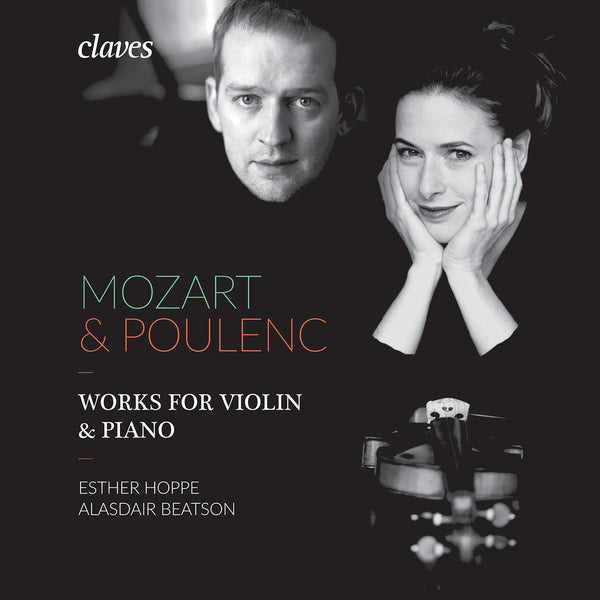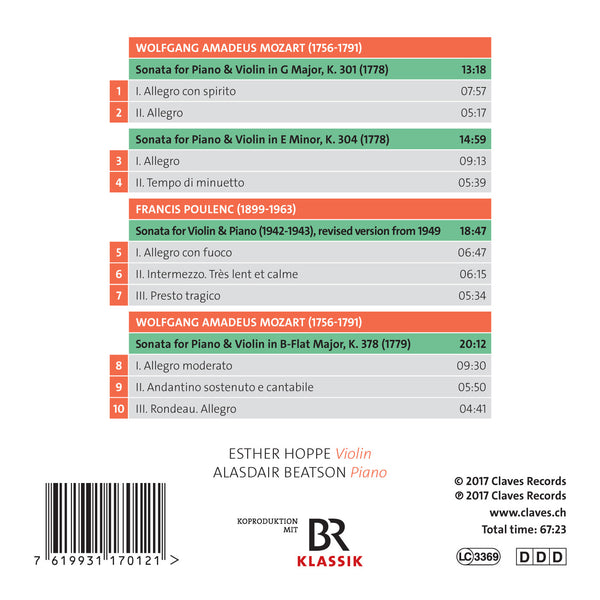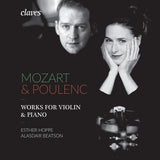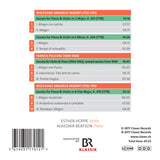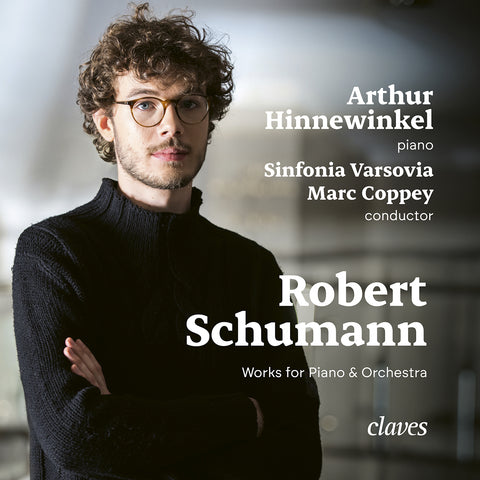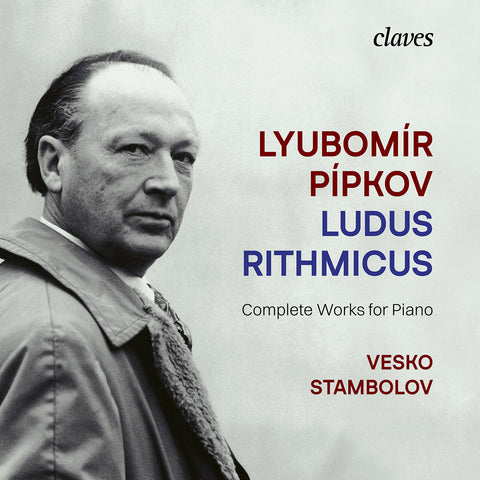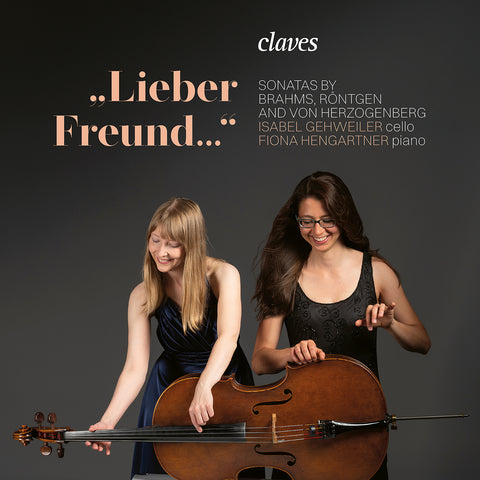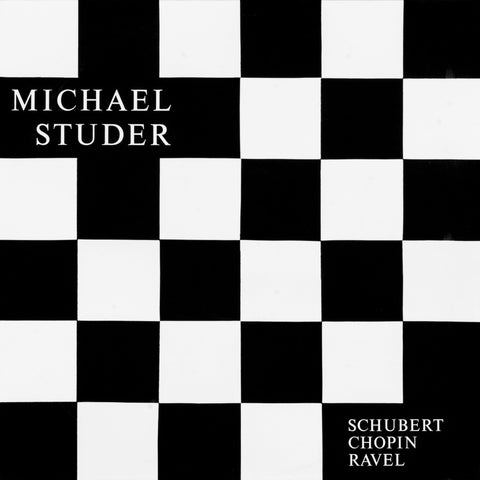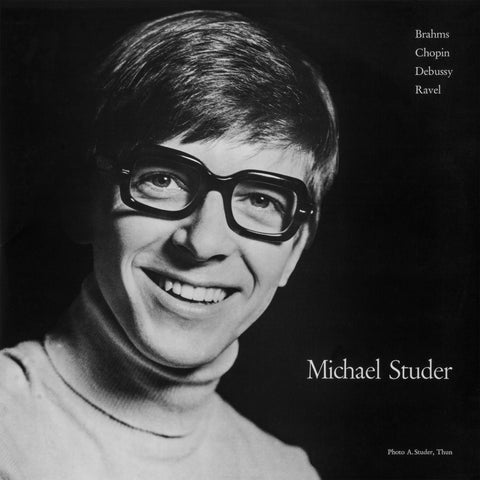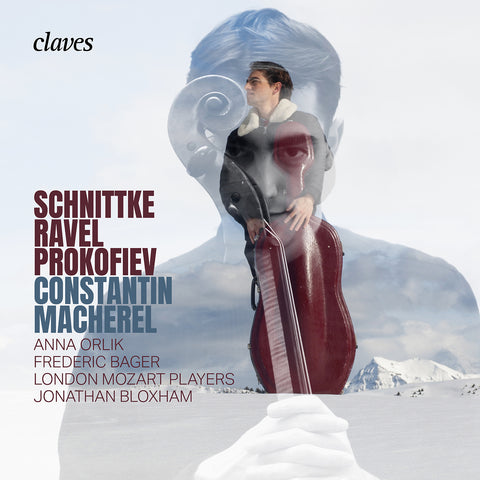(2017) Mozart & Poulenc: Works for Violin & Piano - Esther Hoppe, Alasdair Beatson
Category(ies): Chamber Piano
Instrument(s): Piano Violin
Main Composer: Wolfgang Amadeus Mozart
CD set: 1
Catalog N°:
CD 1701
Release: 20.01.2017
EAN/UPC: 7619931170121
- UPC: 190374892629
This album is now on repressing. Pre-order it at a special price now.
CHF 18.50
This album is no longer available on CD.
This album has not been released yet. Pre-order it from now.
CHF 18.50
This album is no longer available on CD.
CHF 18.50
VAT included for Switzerland & UE
Free shipping
This album is no longer available on CD.
VAT included for Switzerland & UE
Free shipping
This album is now on repressing. Pre-order it at a special price now.
CHF 18.50
This album is no longer available on CD.
This album has not been released yet.
Pre-order it at a special price now.
CHF 18.50
This album is no longer available on CD.
CHF 18.50
This album is no longer available on CD.
MOZART & POULENC: WORKS FOR VIOLIN & PIANO - ESTHER HOPPE, ALASDAIR BEATSON
Notes from the performer
In Munich in 1777, Mozart came across the “Duetti a Clavicembalo e Violino” by Joseph Schuster (1768-1812). These were an early form of the duo sonata in which the violin was becoming increasingly independent and no longer functioned merely as an accompaniment to the harpsichord. Mozart was very fond of these duo sonatas, often played them and was inspired by them when he decided to write a collection of sonatas himself (K 301-306). He dedicated them to Maria Elisabeth von der Pfalz in Mannheim, the wife of the Elector Karl Theodor. They are composed in a concertante style, and come across as spontaneous and light in character.
In February 1778, Mozart wrote his Sonata in G major K 301. It is in two movements, in line with the contemporary custom, namely an “Allegro con spirito” and an “Allegro”. Mozart is supposed to have begun these initially as flute sonatas – he was at the time the recipient of numerous commissions from the wealthy Dutchman De Jean, who was himself a very good flautist. But the second movement has a violinistic middle section in g minor, suggesting that Mozart at the very least finished this sonata as a work for violin and keyboard, even if that was not how it might originally have been intended.
The only work in this collection of sonatas that is in the minor mode is the Sonata in e minor K 304. It is starkly different from its companion pieces. Mozart had meanwhile left Mannheim for Paris, accompanied by his mother. This journey proved a disappointment in various ways, even a disaster, not least because his much-loved mother died in Paris. The depression that he must have suffered in the immediate aftermath is surely reflected quite especially in this e-minor sonata. The dark colourings of this work of resignation make it at once one of the most beautiful and yet saddest works ever written in this genre. It was composed in June 1778 in Paris, just a few months after the Sonata in G major. But while it, too, is cast in two movements, it is very different in character. Both movements are emotionally charged, and at times verge on the dramatic in a manner that even seems prescient of Beethoven. There is a sense of melancholy that pervades the whole work. Even its Minuet is possessed of a sad elegance that is without any hint of joy. Only the intermediary section in E major allows for a moment of cheerful release, though this seems in fact just to emphasize the dark colours that surround it.
In 1781, Mozart published a second volume of violin sonatas, this time dedicated to the pianist Josepha von Aurnhammer. In Cramers Magazin, a contemporary wrote: “These sonatas are truly unique. The violin accompaniment is so cleverly interwoven with the piano part that both instruments demand the same attention throughout. The sonatas require not just a good pianist, but also a violinist who has mastered his instrument through and through”.
The first sonata in this volume, the Sonata in B-flat major K 378, was composed shortly after Mozart’s return from Paris in early 1779. There is no trace of sadness any more here, for this work glitters with brilliance and cheerfulness. Its play of light and dark colours and its abrupt changes in dynamics allow us to perceive a depth of emotion, however, such as was unusual to this degree in the music of the time. The second movement, a highly expressive Andantino, allows both instruments to have an equal say before the work comes to a close with an exuberant, happy Rondeau.
Poulenc once described himself as a “musician without a label”. His favourite composers were Bach, Mozart, Stravinsky and Satie. He studied the piano with Ricardo Viñes, but was almost solely self-taught as a composer, out of fear that he might otherwise copy his teachers. We think we know Poulenc as a neoclassical, witty, cheerful composer who delights in parody and in playing with his models. His serious side is often overlooked, though we find it expressed quite especially in his religious works, in his opera The dialogues of the Carmélites, and in his Violin Sonata.
Poulenc initially found it difficult to come to terms with the violin. He had already made three unsuccessful efforts to write a violin sonata before he finally succeeded at the fourth attempt. He composed it in memory of the poet Federico García Lorca, whom he had admired and who had been killed by the Spanish fascists in 1936. The second movement of the Sonata (“Intermezzo”) is reminiscent of the guitar, and refers to the fact that Lorca liked to sing his verses to his own accompaniment on the instrument. Poulenc was inspired in this movement by the line “La guitarra, / hace llorar a los sueños” (“The guitar makes dreams cry”), from Lorca’s poem “Las seis cuerdas” (“The six strings”). Poulenc composed this Intermezzo first, intending it to be the heart of the work. He then wrote the third movement and finally the first – which he felt had to be impetuous in order to bring balance to the whole work.
It was the violinist Ginette Neveu (1919-1949) who had first urged Poulenc to write a violin sonata. It is presumably thanks to her that we also find a sweetness and elegance of tone in this work. Neveu helped the composer with the violin part, and advised him in technical matters pertaining to the instrument. The Sonata was given its world première on 21 June 1943 in Paris. The audience and the critics were somewhat critical of it, as was Poulenc himself (“my sonata … alas, is not the best of Poulenc”). A revised version of the Sonata was published in 1949, and its final movement, “Presto tragico”, which had referred to Lorca’s fate, now attained tragic contemporary relevance – for Ginette Neveu died on 28 October 1949 in an airplane accident. Poulenc then placed her name next to Lorca’s as the second dedicatee of his Sonata.
Esther Hoppe
Translated from German by Chris Walton
Esther Hoppe
In recent years, Esther Hoppe has established herself as a stylistically confident, virtuosic violinist in both the solo and chamber music repertoires – someone who always places her stupendous technique at the service of the music. After studying with Thomas Füri at the Basel Music Academy, Esther Hoppe went to the Curtis Institute of Music in Philadelphia, where she continued her studies with Robert Mann and Ida Kavafian. She then studied with Yfrah Neaman at the Guildhall School of Music in London and with Nora Chastain at the Zurich University of the Arts. Esther Hoppe has given solo performances with many orchestras, including the Bavarian Radio Symphony Orchestra, the Munich Chamber Orchestra, the Orchestre Les Siècles in Paris, the German State Philharmonic of Rheinland-Pfalz, the kammerorchester basel, the Zurich Chamber Orchestra and the Musikkollegium Winterthur.
After winning 1st prize at the 8th International Mozart Competition in Salzburg in 2002, Esther Hoppe founded the Tecchler Trio. They enjoyed an intensive concert career from 2003 to 2011, winning several first prizes at important competitions, the most significant being 1st Prize at the International ARD Competition in Munich in 2007. From 2009 to 2013 Esther Hoppe was also First Concert Master of the Munich Chamber Orchestra, which she herself directed in many concerts. Since 2013 she has been a professor of violin at the Mozarteum University of Salzburg.
Esther Hoppe’s concert career has taken her to the festivals of Lockenhaus, Lucerne, Davos, Gstaad, Delft, Seville, Prussia Cove and the Styriarte in Graz. She has toured all the countries of Europe, the USA, Japan and India, performing in the Concertgebouw Amsterdam, the Wigmore Hall in London, the Great Hall of the Mozarteum in Salzburg, the Hercules Hall in Munich, the Great Hall of the Tchaikovsky Conservatory in Moscow, the Konzerthaus in Vienna and the Konzerthaus in Dortmund. Esther Hoppe’s chamber music partners include Clemens and Veronika Hagen, Nicolas Altstaedt, Heinz Holliger, Elisabeth Leonskaja, Alexander Lonquich, Aleksandar Madzar, Christian Poltéra and Ronald Brautigam.
Together with the Scottish pianist Alasdair Beatson, Esther Hoppe released a CD with works by Mozart and Stravinsky on the Claves label in 2014 that was highly praised by the critics. Further CDs have been released by Virgin Classics, Neos, Concentus Records and Ars Musici. Esther Hoppe plays a violin made in 1690 by Gioffredo Cappa. She lives with her family in Zurich.
Alasdair Beatson
Pianist Alasdair Beatson is highly regarded as a distinctive and vibrant musician. Highlights of 2014 include a sixth solo Wigmore Recital on July 13th, performances of the complete Beethoven cello sonatas with Pieter Wispelwey, and chamber collaborations with such artists as Adrian Brendel, Philippe Graffin, Erich Höbarth and Pekka Kuusisto. His recent CD of Mendelssohn piano music with SOMM Recordings received praise for highly sensitive playing of rare insight (Classic FM Magazine) and was awarded the 'Outstanding' accolade of International Record Review, and a new disc presenting the complete piano music of Ludwig Thuille was released in April 2013.
Recent concerts include appearances as soloist with the Scottish Chamber Orchestra, Royal Scottish National Orchestra, Britten Sinfonia, the Scottish Ensemble, and performances as soloist in Messiaen's Oiseaux Exotiques, conducted by George Benjamin, and Hindemith's The Four Temperaments. As one of the most established chamber pianists of his generation, Alasdair works in a wide and varied repertoire with some of today's finest musicians. Recent festival appearances include Aldeburgh, Bath Mozartfest, Music at Plush, Resonances (Belgium), Ernen (Switzerland), Delft and Oxford Chamber Music. A regular participant of IMS Prussia Cove, Alasdair was invited to join their touring groups in 2007 and 2011.
He is Artistic Director of the chamber music festival Musique à Marsac. Alasdair enjoys a regular association with the Scottish Ensemble. In addition to numerous chamber music projects, he returns in Autumn 2014 for a third project as soloist, touring concertos of Mozart and Haydn throughout Scotland and at Wigmore Hall.
Often attracted to less familiar repertoire, Alasdair’s approach to programming has been described as canny and uncompromising (Classical Source). His debut solo CD - the opus 1's of Schumann, Brahms, Grieg and Berg - was released on SOMM Recordings in 2009 to critical acclaim. Other uncommon works explored include Debussy’s own arrangement for solo piano of his ballet Jeux, Fauré’s rarely performed Fantaisie for piano and orchestra, Hindemith's Four Temperaments, the complete solo piano music of Ludwig Thuille, and piano trio arrangements of Schönberg's Verklärte Nacht and Janacek's Kreutzer Sonata.
Keen to collaborate directly with living composers, Alasdair has worked closely with George Benjamin, Harrison Birtwistle, Cheryl Frances-Hoad and Heinz Holliger.
(2017) Mozart & Poulenc: Works for Violin & Piano - Esther Hoppe, Alasdair Beatson - CD 1701
Notes from the performer
In Munich in 1777, Mozart came across the “Duetti a Clavicembalo e Violino” by Joseph Schuster (1768-1812). These were an early form of the duo sonata in which the violin was becoming increasingly independent and no longer functioned merely as an accompaniment to the harpsichord. Mozart was very fond of these duo sonatas, often played them and was inspired by them when he decided to write a collection of sonatas himself (K 301-306). He dedicated them to Maria Elisabeth von der Pfalz in Mannheim, the wife of the Elector Karl Theodor. They are composed in a concertante style, and come across as spontaneous and light in character.
In February 1778, Mozart wrote his Sonata in G major K 301. It is in two movements, in line with the contemporary custom, namely an “Allegro con spirito” and an “Allegro”. Mozart is supposed to have begun these initially as flute sonatas – he was at the time the recipient of numerous commissions from the wealthy Dutchman De Jean, who was himself a very good flautist. But the second movement has a violinistic middle section in g minor, suggesting that Mozart at the very least finished this sonata as a work for violin and keyboard, even if that was not how it might originally have been intended.
The only work in this collection of sonatas that is in the minor mode is the Sonata in e minor K 304. It is starkly different from its companion pieces. Mozart had meanwhile left Mannheim for Paris, accompanied by his mother. This journey proved a disappointment in various ways, even a disaster, not least because his much-loved mother died in Paris. The depression that he must have suffered in the immediate aftermath is surely reflected quite especially in this e-minor sonata. The dark colourings of this work of resignation make it at once one of the most beautiful and yet saddest works ever written in this genre. It was composed in June 1778 in Paris, just a few months after the Sonata in G major. But while it, too, is cast in two movements, it is very different in character. Both movements are emotionally charged, and at times verge on the dramatic in a manner that even seems prescient of Beethoven. There is a sense of melancholy that pervades the whole work. Even its Minuet is possessed of a sad elegance that is without any hint of joy. Only the intermediary section in E major allows for a moment of cheerful release, though this seems in fact just to emphasize the dark colours that surround it.
In 1781, Mozart published a second volume of violin sonatas, this time dedicated to the pianist Josepha von Aurnhammer. In Cramers Magazin, a contemporary wrote: “These sonatas are truly unique. The violin accompaniment is so cleverly interwoven with the piano part that both instruments demand the same attention throughout. The sonatas require not just a good pianist, but also a violinist who has mastered his instrument through and through”.
The first sonata in this volume, the Sonata in B-flat major K 378, was composed shortly after Mozart’s return from Paris in early 1779. There is no trace of sadness any more here, for this work glitters with brilliance and cheerfulness. Its play of light and dark colours and its abrupt changes in dynamics allow us to perceive a depth of emotion, however, such as was unusual to this degree in the music of the time. The second movement, a highly expressive Andantino, allows both instruments to have an equal say before the work comes to a close with an exuberant, happy Rondeau.
Poulenc once described himself as a “musician without a label”. His favourite composers were Bach, Mozart, Stravinsky and Satie. He studied the piano with Ricardo Viñes, but was almost solely self-taught as a composer, out of fear that he might otherwise copy his teachers. We think we know Poulenc as a neoclassical, witty, cheerful composer who delights in parody and in playing with his models. His serious side is often overlooked, though we find it expressed quite especially in his religious works, in his opera The dialogues of the Carmélites, and in his Violin Sonata.
Poulenc initially found it difficult to come to terms with the violin. He had already made three unsuccessful efforts to write a violin sonata before he finally succeeded at the fourth attempt. He composed it in memory of the poet Federico García Lorca, whom he had admired and who had been killed by the Spanish fascists in 1936. The second movement of the Sonata (“Intermezzo”) is reminiscent of the guitar, and refers to the fact that Lorca liked to sing his verses to his own accompaniment on the instrument. Poulenc was inspired in this movement by the line “La guitarra, / hace llorar a los sueños” (“The guitar makes dreams cry”), from Lorca’s poem “Las seis cuerdas” (“The six strings”). Poulenc composed this Intermezzo first, intending it to be the heart of the work. He then wrote the third movement and finally the first – which he felt had to be impetuous in order to bring balance to the whole work.
It was the violinist Ginette Neveu (1919-1949) who had first urged Poulenc to write a violin sonata. It is presumably thanks to her that we also find a sweetness and elegance of tone in this work. Neveu helped the composer with the violin part, and advised him in technical matters pertaining to the instrument. The Sonata was given its world première on 21 June 1943 in Paris. The audience and the critics were somewhat critical of it, as was Poulenc himself (“my sonata … alas, is not the best of Poulenc”). A revised version of the Sonata was published in 1949, and its final movement, “Presto tragico”, which had referred to Lorca’s fate, now attained tragic contemporary relevance – for Ginette Neveu died on 28 October 1949 in an airplane accident. Poulenc then placed her name next to Lorca’s as the second dedicatee of his Sonata.
Esther Hoppe
Translated from German by Chris Walton
Esther Hoppe
In recent years, Esther Hoppe has established herself as a stylistically confident, virtuosic violinist in both the solo and chamber music repertoires – someone who always places her stupendous technique at the service of the music. After studying with Thomas Füri at the Basel Music Academy, Esther Hoppe went to the Curtis Institute of Music in Philadelphia, where she continued her studies with Robert Mann and Ida Kavafian. She then studied with Yfrah Neaman at the Guildhall School of Music in London and with Nora Chastain at the Zurich University of the Arts. Esther Hoppe has given solo performances with many orchestras, including the Bavarian Radio Symphony Orchestra, the Munich Chamber Orchestra, the Orchestre Les Siècles in Paris, the German State Philharmonic of Rheinland-Pfalz, the kammerorchester basel, the Zurich Chamber Orchestra and the Musikkollegium Winterthur.
After winning 1st prize at the 8th International Mozart Competition in Salzburg in 2002, Esther Hoppe founded the Tecchler Trio. They enjoyed an intensive concert career from 2003 to 2011, winning several first prizes at important competitions, the most significant being 1st Prize at the International ARD Competition in Munich in 2007. From 2009 to 2013 Esther Hoppe was also First Concert Master of the Munich Chamber Orchestra, which she herself directed in many concerts. Since 2013 she has been a professor of violin at the Mozarteum University of Salzburg.
Esther Hoppe’s concert career has taken her to the festivals of Lockenhaus, Lucerne, Davos, Gstaad, Delft, Seville, Prussia Cove and the Styriarte in Graz. She has toured all the countries of Europe, the USA, Japan and India, performing in the Concertgebouw Amsterdam, the Wigmore Hall in London, the Great Hall of the Mozarteum in Salzburg, the Hercules Hall in Munich, the Great Hall of the Tchaikovsky Conservatory in Moscow, the Konzerthaus in Vienna and the Konzerthaus in Dortmund. Esther Hoppe’s chamber music partners include Clemens and Veronika Hagen, Nicolas Altstaedt, Heinz Holliger, Elisabeth Leonskaja, Alexander Lonquich, Aleksandar Madzar, Christian Poltéra and Ronald Brautigam.
Together with the Scottish pianist Alasdair Beatson, Esther Hoppe released a CD with works by Mozart and Stravinsky on the Claves label in 2014 that was highly praised by the critics. Further CDs have been released by Virgin Classics, Neos, Concentus Records and Ars Musici. Esther Hoppe plays a violin made in 1690 by Gioffredo Cappa. She lives with her family in Zurich.
Alasdair Beatson
Pianist Alasdair Beatson is highly regarded as a distinctive and vibrant musician. Highlights of 2014 include a sixth solo Wigmore Recital on July 13th, performances of the complete Beethoven cello sonatas with Pieter Wispelwey, and chamber collaborations with such artists as Adrian Brendel, Philippe Graffin, Erich Höbarth and Pekka Kuusisto. His recent CD of Mendelssohn piano music with SOMM Recordings received praise for highly sensitive playing of rare insight (Classic FM Magazine) and was awarded the 'Outstanding' accolade of International Record Review, and a new disc presenting the complete piano music of Ludwig Thuille was released in April 2013.
Recent concerts include appearances as soloist with the Scottish Chamber Orchestra, Royal Scottish National Orchestra, Britten Sinfonia, the Scottish Ensemble, and performances as soloist in Messiaen's Oiseaux Exotiques, conducted by George Benjamin, and Hindemith's The Four Temperaments. As one of the most established chamber pianists of his generation, Alasdair works in a wide and varied repertoire with some of today's finest musicians. Recent festival appearances include Aldeburgh, Bath Mozartfest, Music at Plush, Resonances (Belgium), Ernen (Switzerland), Delft and Oxford Chamber Music. A regular participant of IMS Prussia Cove, Alasdair was invited to join their touring groups in 2007 and 2011.
He is Artistic Director of the chamber music festival Musique à Marsac. Alasdair enjoys a regular association with the Scottish Ensemble. In addition to numerous chamber music projects, he returns in Autumn 2014 for a third project as soloist, touring concertos of Mozart and Haydn throughout Scotland and at Wigmore Hall.
Often attracted to less familiar repertoire, Alasdair’s approach to programming has been described as canny and uncompromising (Classical Source). His debut solo CD - the opus 1's of Schumann, Brahms, Grieg and Berg - was released on SOMM Recordings in 2009 to critical acclaim. Other uncommon works explored include Debussy’s own arrangement for solo piano of his ballet Jeux, Fauré’s rarely performed Fantaisie for piano and orchestra, Hindemith's Four Temperaments, the complete solo piano music of Ludwig Thuille, and piano trio arrangements of Schönberg's Verklärte Nacht and Janacek's Kreutzer Sonata.
Keen to collaborate directly with living composers, Alasdair has worked closely with George Benjamin, Harrison Birtwistle, Cheryl Frances-Hoad and Heinz Holliger.
Return to the album | Read the booklet | Composer(s): Wolfgang Amadeus Mozart | Main Artist: Esther Hoppe






